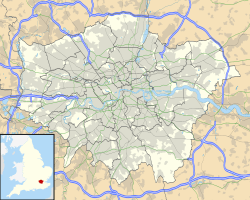Iverna Gardens drill hall facts for kids
Quick facts for kids Iverna Gardens drill hall |
|
|---|---|
| Kensington, London | |

Iverna Gardens drill hall
|
|
|
Location within London
|
|
| Coordinates | 51°29′55″N 0°11′38″W / 51.49851°N 0.19395°W |
| Type | Drill Hall |
| Site history | |
| Built | 1903 |
| Built for | War Office |
| In use | 1903-Present |
The Iverna Gardens drill hall is a special building in Kensington, London. It has been used by the military for over 100 years. Think of it as a training center and home base for soldiers.
Contents
A Look Back: The Hall's History
The Iverna Gardens drill hall was built in 1903. It was designed to be the main home for a group of volunteer soldiers. This group was called the 4th (Kensington) Middlesex Volunteer Rifle Corps. These volunteers practiced shooting and military drills.
From Volunteers to Regiments
In 1908, the volunteer group changed its name. It became the 13th (County of London) Battalion, London Regiment (Kensington). This was a more official part of the British Army.
World War I and Changes
When World War I started in August 1914, soldiers from this battalion got ready for war at the drill hall. They were then sent to fight on the Western Front, which was in France and Belgium.
After many years, in 1936, the London Regiment was reorganized. The unit at Iverna Gardens changed its name again. It became the Princess Louise's Kensington Regiment, The Middlesex Regiment.
World War II and New Occupants
At the start of World War II, this regiment was sent to France. They were part of the British Expeditionary Force. However, after the war, they did not return to the Iverna Gardens drill hall.
Instead, in 1939, a new group moved in. This was the 99th (London Welsh) Heavy Anti-Aircraft Regiment, Royal Artillery. This unit used big guns to shoot down enemy planes. They fought in North West Europe during the final parts of World War II.
Post-War and Modern Use
After the war, in 1947, the anti-aircraft regiment changed its name to the 499th (London Welsh) Heavy Anti-Aircraft Regiment Royal Artillery. By 1951, not many Welsh soldiers were left in the group. So, in 1952, the local council, the Royal Borough of Kensington, adopted the regiment. It changed its name one last time to the 499th (Kensington) Heavy Anti-Aircraft Regiment, RA. This unit was eventually closed down in 1955.
Today, the Iverna Gardens drill hall is still used by the military. Since 2014, it has been the home of B Detachment 256 (City of London) Field Hospital. This is a unit that provides medical support to soldiers.


